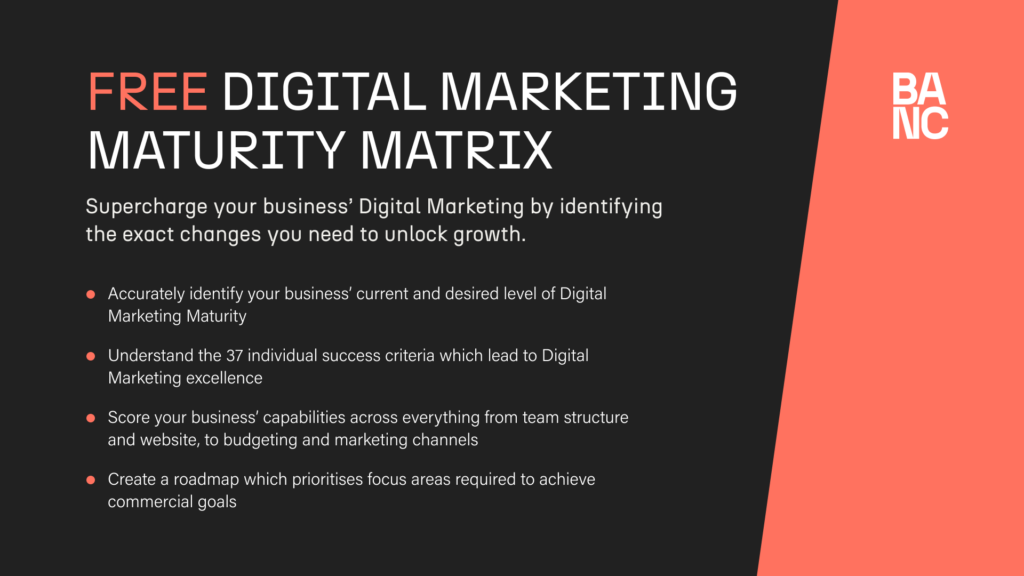Digital Marketing Strategy vs. Tactics: What’s the Difference?
Strategy and tactics with regards to digital marketing sound pretty similar, right? After all, they both relate to the activity and approaches that’ll get you closer to your goals. But there’s a difference – and we’ll lay out the distinctions so you can strengthen both of them on the way towards optimising your digital marketing.
What is a digital marketing strategy?
We’ve talked about digital marketing strategies plenty of times on the blog before (you can find a more in-depth explanation of them here), but consider this a quick crash course on what they are.
A digital marketing strategy is a plan for reaching specific marketing-related goals in ways that are focused and achievable. A strategy weighs up your strengths and weaknesses against your objectives, and then sets out the activities you’ll you use to meet them. This is done through marketing channels such as organic search, social media, paid ads and plenty of other digital methods.
What is the purpose of a digital marketing strategy?
There’s no shortage of why agencies use digital marketing strategies, but here are the reasons we use them when working with our clients:
- They give our clients’ marketing activities a clear direction
- They help to connect brands to their key target audience
- Through the right tactics (that word again) and channels, they boost brand awareness
- They save time and money since we know to only pursue things that bring in results
- They let us track what is and isn’t working
- They make sure our clients can stay competitive
What should a digital marketing strategy include?
Generally, a digital marketing strategy will include the following elements…
Goals and objectives
The starting point of any strategy, goals and objectives are what give the whole thing direction. Much like strategy and tactics, goals and objectives sound the same, but there’s a difference.
Goals take a broader view. Objectives fine tune things, they’re more specific and might have a deadline. So, a goal might be something like “we want more sales”. The corresponding objective will then be “Increase sales by 15% in the next three months”. There’s both a quantifiable amount and a timeframe to this which adds more specificity.

Audience analysis
Knowing who you’re marketing activity will be tailored to is absolutely vital. Once you get a hold on their background, whether it’s age, location, income, hobbies or problems, you’ll have specific info on them that you can craft activity around.
Don’t forget to research where they can be found online either – doing so let’s pick the platforms that you know your audience use, which you can then use to target them through.
Content plan
You’ll need to put your audience under the magnifying glass again here. This time, investigating the types of content they love to engage with will give you plenty to stock up your content plan with.
Remember to keep things varied. Create blogs, emails, videos and other content that you know will speak to your audience. You can also form your content on content pillars – ideas, values and themes that appeal to those you’re targeting.
Data analytics
Your strategy should also make use of analytics and metrics so you’ll know how well your campaigns are performing. Without them, your efforts will be a bit on the random side. But with these key figures to hand, you’ll know what’s working and which pieces of content aren’t connecting.
From here, you’ll be able to refine your approach, optimising content to improve your chances of catching their attention – and keeping it focused on you above your competition.
When should you create a digital marketing strategy?
If you’ve been going off gut instincts, posting content at random, irregular intervals, and failing to measure metrics – without anything in the way of results or ROI, of course – then now’s the time to create a digital marketing strategy.
Strategies take out hunches and intuition. They keep content coming out at a steady pace that your audience know when to expect, and crucially, they make sure the content you’re posting actually appeals to them. A well-planned and executed strategy leaves nothing to chance; they take out random and put in results.
What are digital marketing tactics?
Digital marketing tactics are the actions your business will use to put strategy in motion and achieve the goals and objectives contained within it. They’re specific, actionable and measurable, and often, they’re relatively short term.
What are they used for?
Tactics are what shape the content creation aspects of your strategy. If the strategy is a skeleton, then the tactics are the muscles that’ll give it movement on the way towards achieving what your business wants to achieve.
Examples of digital marketing tactics
There are no shortage of digital marketing tactics. The ones you’ll use depend on the specifics of your strategy of course, but may involve the below…
- Content marketing including mobile content, native advertising and influencer marketing
- Email marketing to generate more leads, sales and conversions
- Social media marketing to increase brand awareness and audience following
- Video content that strengthens your brand’s personality and storytelling
- Web design that’s optimised for both desktop and mobile
- Paid media to prospect, remarket and retarget leads

What’s the difference between digital marketing strategy and tactics?
An easy way to look at the distinction between the two is that strategy is the theory, and tactics are all about putting that theory into practice. They the specific actions that are what you’ll use to execute the outline of the strategy, which is high-level, long term and provides direction.
How mature is your digital marketing?
An important part of levelling up your digital marketing is assessing the stage of maturity your business is at. Without it, you run the risk of not looking before you leap, attempting areas of activity before you’ve fully matured in others.
When you have identified your level of maturity, however, you’ll know what you need to do to reach the next stage of activity – and the goals they’ll help you pursue.
So what can be done to find your current and desired level of maturity? By taking our self-assessment quiz below. It’s quick, simple and shows you exactly what your current capabilities are – and what you need to change so you can speed up your commercial growth.
Download your free Digital Marketing Maturity Matrix
That’s not all, our downloadable matrix will help you score these capabilities across 37 individual criteria, which you can then use to create a roadmap for future success.
Fill in the form below to get started!

Still not sure how to create a strategy that’ll get results? Our digital marketing consultants can shape one for you, connecting your business to greater success through achievable goals. Head here to learn more or give us a call on 0345 459 0558.



